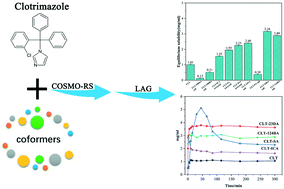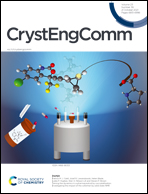Multicomponent crystals of clotrimazole: a combined theoretical and experimental study†
Abstract
In order to improve the aqueous solubility of clotrimazole (CLT), an effective antifungal agent, its new multicomponent crystals were developed according to crystal engineering. To efficiently synthesize the multicomponent solids, a protocol which combined a virtual cocrystal screening tool based on the conductor-like screening model for realistic solvents (COSMO-RS) and the experimental liquid-assisted grinding (LAG) method was applied. As a result, fourteen multicomponent crystals were obtained from 21 potential coformers, including 5 previously reported ones. Nine novel multicomponent crystals were identified and characterized by single crystal X-ray diffraction, powder X-ray diffraction, differential scanning calorimetry, thermogravimetric analysis and Fourier-transform infrared spectroscopy. Intermolecular interactions were elucidated by Hirshfeld surface analysis, and the origin of the cocrystals/salts was explained using molecular electrostatic potential surfaces. Finally, powder dissolution experiments were carried out. Compared with CLT, some multicomponent crystals showed an improvement in solubility (3.13–1.53 times) and dissolution rate.

- This article is part of the themed collection: Crystal Engineering Techniques


 Please wait while we load your content...
Please wait while we load your content...